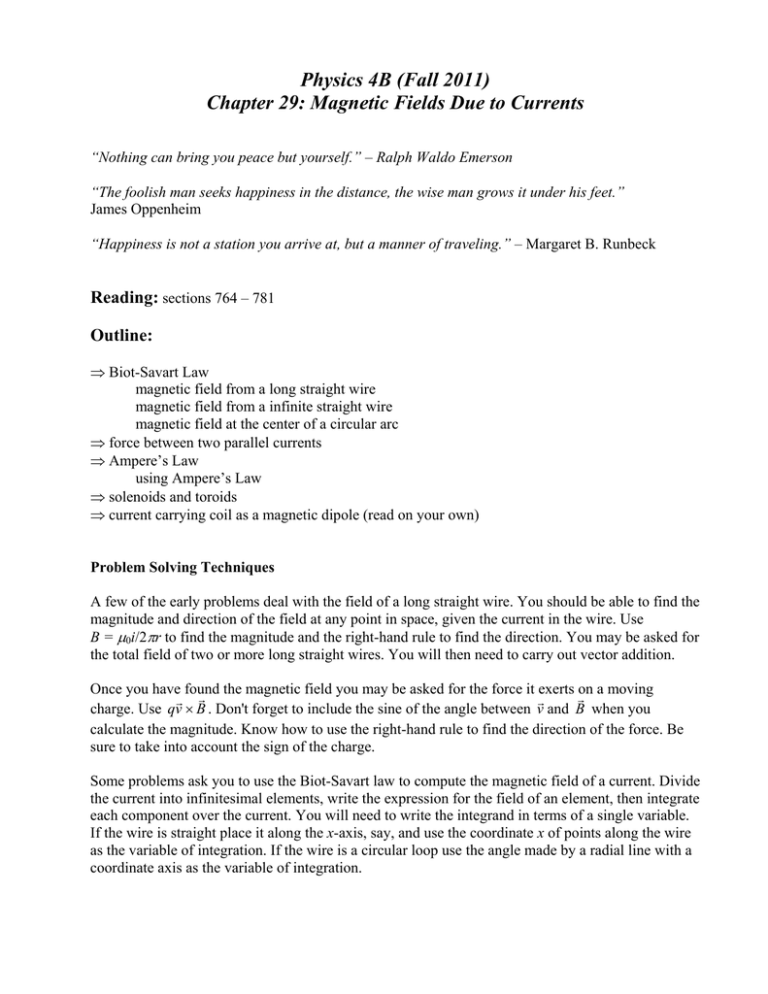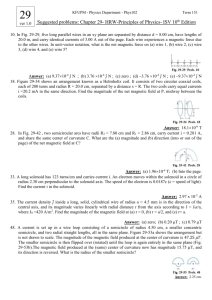Physics 4B (Fall 2011) Chapter 29: Magnetic Fields Due to Currents
advertisement

Physics 4B (Fall 2011) Chapter 29: Magnetic Fields Due to Currents “Nothing can bring you peace but yourself.” – Ralph Waldo Emerson “The foolish man seeks happiness in the distance, the wise man grows it under his feet.” James Oppenheim “Happiness is not a station you arrive at, but a manner of traveling.” – Margaret B. Runbeck Reading: sections 764 – 781 Outline: ⇒ Biot-Savart Law magnetic field from a long straight wire magnetic field from a infinite straight wire magnetic field at the center of a circular arc ⇒ force between two parallel currents ⇒ Ampere’s Law using Ampere’s Law ⇒ solenoids and toroids ⇒ current carrying coil as a magnetic dipole (read on your own) Problem Solving Techniques A few of the early problems deal with the field of a long straight wire. You should be able to find the magnitude and direction of the field at any point in space, given the current in the wire. Use B = μ0i/2πr to find the magnitude and the right-hand rule to find the direction. You may be asked for the total field of two or more long straight wires. You will then need to carry out vector addition. Once you have found the magnetic field you may be asked for the force it exerts on a moving charge. Use qv × B . Don't forget to include the sine of the angle between v and B when you calculate the magnitude. Know how to use the right-hand rule to find the direction of the force. Be sure to take into account the sign of the charge. Some problems ask you to use the Biot-Savart law to compute the magnetic field of a current. Divide the current into infinitesimal elements, write the expression for the field of an element, then integrate each component over the current. You will need to write the integrand in terms of a single variable. If the wire is straight place it along the x-axis, say, and use the coordinate x of points along the wire as the variable of integration. If the wire is a circular loop use the angle made by a radial line with a coordinate axis as the variable of integration. In many cases you may think of an electrical circuit as composed of finite straight-line and circulararc segments, each of which produces a magnetic field. You can then calculate the field produced by each segment and vectorially sum the individual fields to find the total field. Use the result given in Problem 11 if you need to find the field on the perpendicular bisector of a finite straight wire. To find the field at some other point you sill need to integrate the Biot-Savart law. Use the procedure given in Section 1 for an infinite wire but replace the limits of integration with finite values. Use B = μ0iφ /4πR for the field of a circular arc at its center of curvature. Some problems ask you to use what you learned in the last chapter to calculate the force that one wire exerts on another. Ampere's law problems take three forms. The most straightforward give the currents and ask you to find the value of ∫ B i ds around a given path. You must pay attention to the directions of the currents as they pierce the plane of the path and carefully observe which currents are encircled by the path and which are not. Other problems ask you to use Ampere's law to calculate the magnetic field. Carefully choose the Amperian path you will use and pay attention to the evaluation of the Ampere's law integral in terms of the unknown field. Still other problems give you the magnetic field as a function of position and ask for the current through a given region. Carry out the line integral of the tangential component of the field around the boundary of the region and equate the result to μ0i, then solve for i. You should know how to compute the magnetic fields of some special current configurations (in addition to a long straight wire): a solenoid, a toroid, and a magnetic dipole. The field of an ideal solenoid is given by B = μ0ni inside the solenoid and by B = 0 outside. The field inside is along the cylinder axis. The field of a toroid is given by B = μ0iN/2πr at a point inside, a distance r from the center. The field inside the hole and outside the toroid is zero. The field lines inside are circles that at concentric with the toroid. The field of a magnetic dipole is given by = μ0 /2πz3 at a point on the axis defined by the direction of the dipole moment, a distance z from the dipole. You should recall from the last chapter how to find the dipole moment of a current loop (both magnitude and direction) and how to compute the torque of a uniform magnetic field on a dipole. Questions and Example Problems from Chapter 29 Question 1 The figure below shows four arrangements in which long parallel wires carry equal currents directly into or out of the page at the corners of identical squares. Rank the arrangements according to the magnitude of the net magnetic field at the center of the square, greatest first. Question 2 The Figure below shows three circuits, each consisting of two radial lengths and two concentric arcs, one of radius r and the other of radius R > r. The circuits have the same current through them and the same angle between the two radial lengths. Rank the circuits according to the magnitude of the net magnetic field at the center, greatest first. Problem 1 In the figure below, two long straight wires at separation d = 16.0 cm carry current i1 = 3.61 mA and i2 = 3.00i1 out of the page. (a) At what point on the x axis shown is the net magnetic field due to the currents equal to zero? (b) If the two currents are doubled, is the point of zero magnetic field shift toward wire 1, shifted toward wire 2, or unchanged? Problem 2 In the figure below, a current i = 10 A is set up in a long hairpin conductor formed by bending a wire into a semicircle of radius R = 5.0 mm. Point b is midway between the straight sections and so distant from the semicircle that each section can be approximated as being an infinite wire. What are the (a) magnitude and (b) direction (into or out of the page) of B at point a and the (c) magnitude and (d) direction of B at point b. Problem 3 In the figure below, a wire forms a semicircle of radius R = 9.26 cm and two (radial) straight segments each of length L = 13.1 cm. The wire carries current i = 34.8 mA. What are the (a) magnitude and (b) direction (into or out of the page) of the net magnetic field at the semicircle’s center of curvature C? Problem 4 In the figure below, point P2 is at perpendicular distance R = 25.1 cm from one end of straight wire of length L = 13.6 cm carrying current i= 0.693 A. (Note that the wire is not long.) What is the magnitude of the magnetic field at P2? Problem 5 In the figure below, four long straight wires are perpendicular to the page, and their cross sections form a square of edge length a = 8.50 cm. Each wire carries 15.0 A, and all the currents are out of the page. In unit-vector notation, what is the net magnetic field force per meter of wire length on wire 1? Problem 6 The figure below shows two very long straight wires (in cross section) that each carry a current of 4.00 A directly out of the page. Distance d1 = 6.00 m and distance d2 = 4.00 m. What is the magnitude of the net magnetic field at point P, which lies on a perpendicular bisector of the wires? Problem 7 Show that a uniform magnetic field cannot drop abruptly to zero (as is suggested by the lack of field lines to the right of point a in the figure below) as one moves perpendicular to B , say along the horizontal arrow in the figure. (Hint: Apply Ampere's law to the rectangular path shown by the dashed lines.) In actual magnets “fringing” of the magnetic field lines always occurs, which means that B approaches zero in a gradual manner. Modify the field lines in the figure to indicate a more realistic situation. Problem 8 A solenoid 1.30 m long and 2.60 cm in diameter carries a current of 18.0 A. The magnetic field inside the solenoid is 23.0 mT. Find the length of the wire forming the solenoid. Problem 9 A long solenoid has 100 turns/cm and carries current i. An electron moves within the solenoid in a circle of radius 2.30 cm perpendicular to the solenoid axis. The speed of the electron is 0.0460c (c = speed of light). Find the current i in the solenoid. Problem 10 The figure below shows an arrangement known as a Helmholtz coil. It consists of two circular coaxial coils, each of 200 turns and radius R = 25.0 cm, separated by a distance s = R. The two coils carry equal currents i = 12.2 mA in the same direction. Find the magnitude of the net magnetic field at P, midway between the coils. Problem 11 In the figure below, current i = 56.2 mA is set up in a loop having two radial lengths and two semicircles of radii a = 5.72 cm and b = 9.36 cm with a common center P. What are the (a) magnitude and (b) direction (into or out of the page) of the magnetic field at P and the (c) magnitude and (d) direction of the loop’s magnetic dipole moment?







